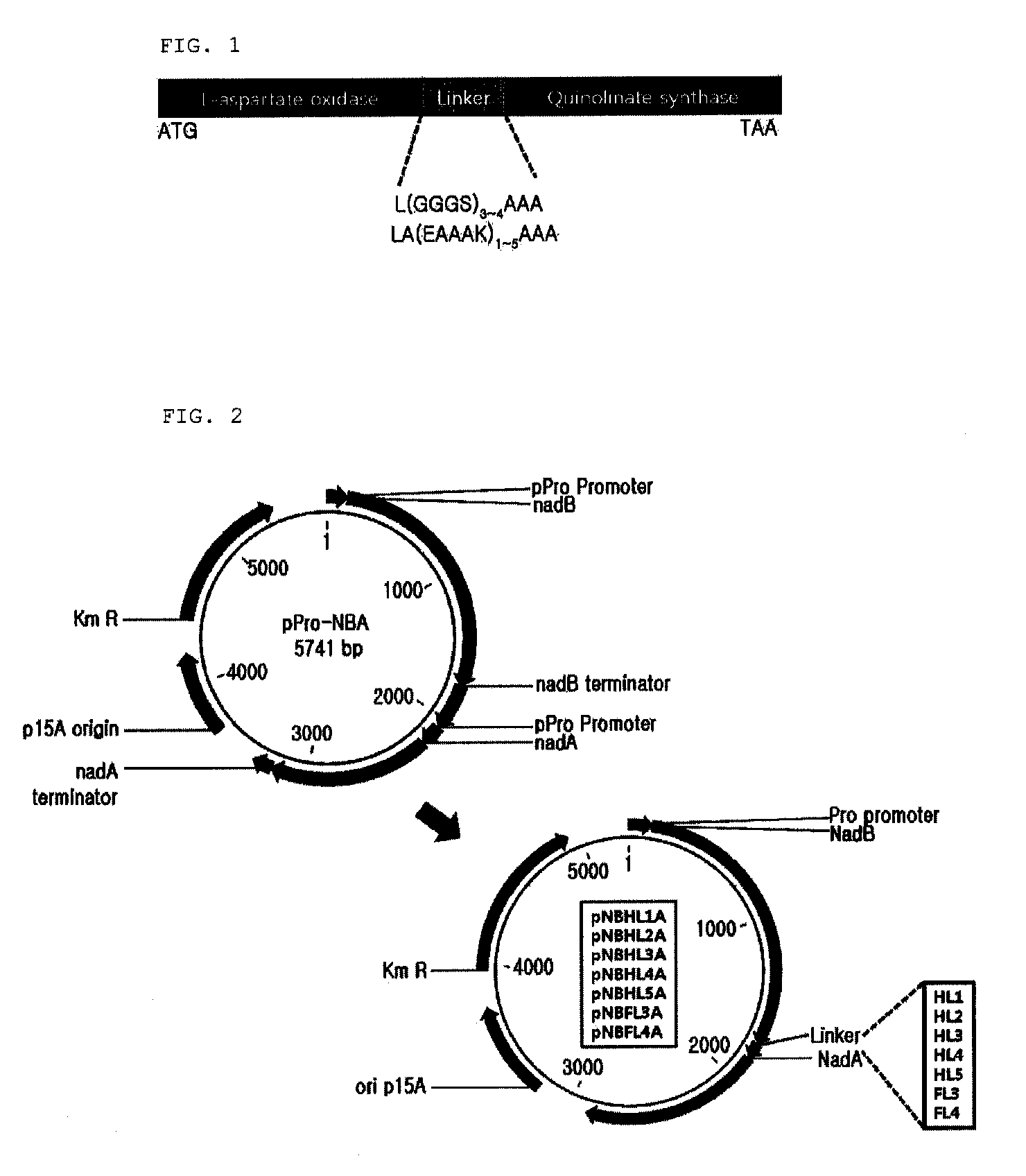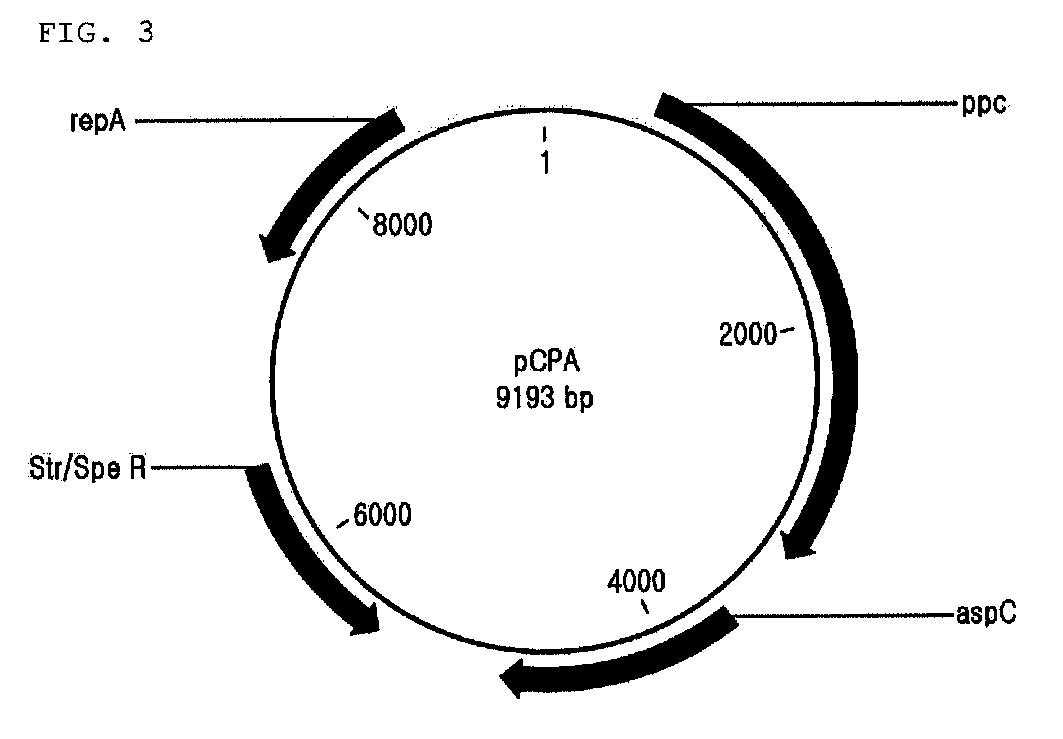Recombinant microorganism producing quinolinic acid and a method for producing quinolinic acid using the same
a technology of quinolinic acid and recombinant microorganisms, which is applied in the direction of mechanical equipment, bulk chemical production, transferases, etc., can solve the problems of low collision frequency between substrate and enzyme, large amount of by-products, and no attempt to solve the above problem regarding the production of quinolinic acid
- Summary
- Abstract
- Description
- Claims
- Application Information
AI Technical Summary
Benefits of technology
Problems solved by technology
Method used
Image
Examples
example 1
Preparation of the Stain Producing Quinolinic Acid
[0074] Construction of Plasmid Expressing L-aspartate Oxidase
[0075]The gene nadB encoding L-aspartate oxidase was obtained through PCR using chromosomal DNA of E. coli W3110 as a template. Based on the nucleotide sequence for the nadB gene (NCBI Registration No. “GI: 89109380”) of SEQ ID NO. 27 obtained from the GenBank of US National Institute of Health (NIH GenBank), the ORF region containing from ATG to TAA in nadB gene could be amplified, and primers of SEQ ID NOs. 1 and 2 having the recognition sites of restriction enzymes NdeI and BamHI were synthesized.
[0076]PCR was conducted using chromosomal DNA of E. coli W3110 as the template and oligonucleotides of SEQ ID NO. 1 and 2 as the primer. PfuUltra™ DNA polymerase (Stratagene) was used as the polymerase, and PCR was conducted by repeating the cycle 30 times including denaturation at 96° C. for 30 seconds, annealing at 50° C. for 30 seconds and extension at 72° C. for 2 minutes. T...
example 2
Preparation and Evaluation of Fusion Protein-expressing Strain
[0102] Preparation of Fusion Protein-Expressing Strain
[0103]The pNBHL1A, pNBHL2A, pNBHL3A, pNBHL4A, pNBHL5A, pNBFL3A and pNBFL4A and pPro-NBA plasmids expressing genes encoding the single fusion proteins which were prepared by linking L-aspartate oxidase and quinolinate synthase via various linkers of were used through CaCl2 method to transform W3110ΔnadC strain as constructed in , which were then smeared on LB-Km plating medium (yeast extract 10 g / L, NaCl 5 g / L, tryptone 10 g / L, kanamycin 25 μg / L) and incubated at 37° C. overnight. Then, kanamycin-resistant colonies were selected. Therefore, strains expressing L-aspartate oxidase and quinolinate synthase as a single fusion protein were obtained.
[0104] Comparison of Productivity of Quinolinic Acid from Aspartic Acid between Fusion Proteins having Various Linkers
[0105]In order to compare the ability to synthesize quinolinic acid from aspartic acid between fusion proteins ...
example 3
Preparation and Evaluation of Quinolinic Acid-producing Strain
[0112] Preparation of Quinolinic Acid-producing Strain
[0113]In order to compare the ability to synthesize quinolinic acid from glucose between fusion proteins having various linkers, the pCPA plasmid constructed in was used through CaCl2 method to transform W3110ΔnadC strain as constructed in , which were then smeared on LB-SP plating medium (yeast extract 10 g / L, NaCl 5 g / L, tryptone 10 g / L, spectinomycin 50 μg / L) and incubated at 37° C. overnight. Then, spectinomycin-resistant colonies were selected.
[0114]pPro-NBA, pNBHL1A, pNBHL2A, pNBHL3A, pNBHL4A, pNBHL5A, pNBFL3A and pNBFL4A plasmids constructed in and were used through CaCl2 method to transform W3110ΔnadC strain containing pCPA constructed as above, which were then smeared on LB-Km-Sp plating medium (yeast extract 10 g / L, NaCl 5 g / L, tryptone 10 g / L, spectinomycin 50 μg / L, kanamycin 25 μg / L) and incubated at 37° C. overnight. Thereafter, each 10 of kanamycin and...
PUM
| Property | Measurement | Unit |
|---|---|---|
| concentration | aaaaa | aaaaa |
| pH | aaaaa | aaaaa |
| temperature | aaaaa | aaaaa |
Abstract
Description
Claims
Application Information
 Login to View More
Login to View More - R&D
- Intellectual Property
- Life Sciences
- Materials
- Tech Scout
- Unparalleled Data Quality
- Higher Quality Content
- 60% Fewer Hallucinations
Browse by: Latest US Patents, China's latest patents, Technical Efficacy Thesaurus, Application Domain, Technology Topic, Popular Technical Reports.
© 2025 PatSnap. All rights reserved.Legal|Privacy policy|Modern Slavery Act Transparency Statement|Sitemap|About US| Contact US: help@patsnap.com


